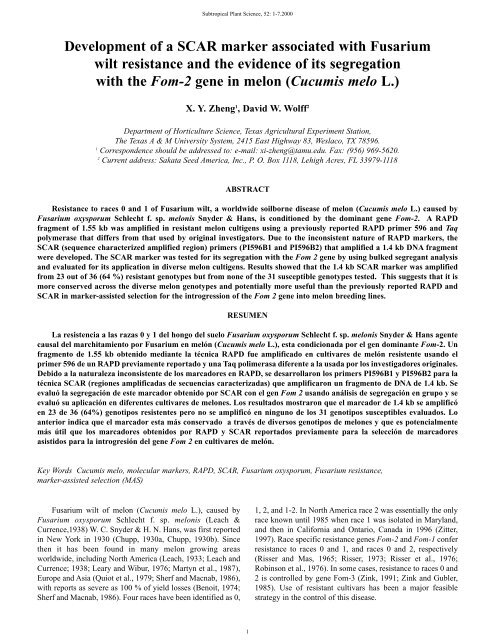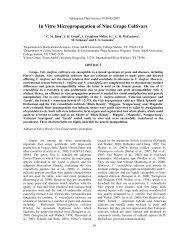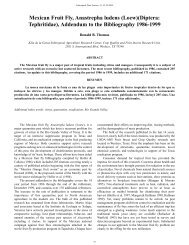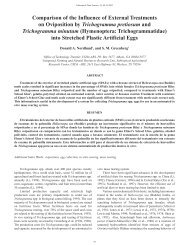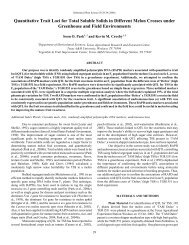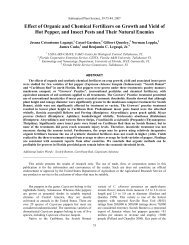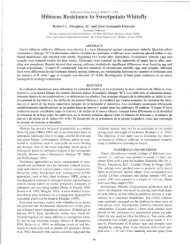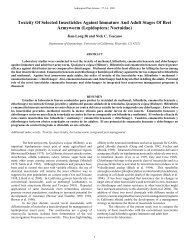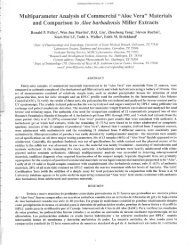Subtropical Plant Sci. J. 52:1-7. - Subtropical Plant Science Society
Subtropical Plant Sci. J. 52:1-7. - Subtropical Plant Science Society
Subtropical Plant Sci. J. 52:1-7. - Subtropical Plant Science Society
You also want an ePaper? Increase the reach of your titles
YUMPU automatically turns print PDFs into web optimized ePapers that Google loves.
<strong>Subtropical</strong> <strong>Plant</strong> <strong>Sci</strong>ence, <strong>52</strong>: 1-<strong>7.</strong>2000<br />
Development of a SCAR marker associated with Fusarium<br />
wilt resistance and the evidence of its segregation<br />
with the Fom-2 gene in melon (Cucumis melo L.)<br />
X. Y. Zheng 1 , David W. Wolff 2<br />
Department of Horticulture <strong>Sci</strong>ence, Texas Agricultural Experiment Station,<br />
The Texas A & M University System, 2415 East Highway 83, Weslaco, TX 78596.<br />
1<br />
Correspondence should be addressed to: e-mail: xi-zheng@tamu.edu. Fax: (956) 969-5620.<br />
2<br />
Current address: Sakata Seed America, Inc., P. O. Box 1118, Lehigh Acres, FL 33979-1118<br />
ABSTRACT<br />
Resistance to races 0 and 1 of Fusarium wilt, a worldwide soilborne disease of melon (Cucumis melo L.) caused by<br />
Fusarium oxysporum Schlecht f. sp. melonis Snyder & Hans, is conditioned by the dominant gene Fom-2. A RAPD<br />
fragment of 1.55 kb was amplified in resistant melon cultigens using a previously reported RAPD primer 596 and Taq<br />
polymerase that differs from that used by original investigators. Due to the inconsistent nature of RAPD markers, the<br />
SCAR (sequence characterized amplified region) primers (PI596B1 and PI596B2) that amplified a 1.4 kb DNA fragment<br />
were developed. The SCAR marker was tested for its segregation with the Fom 2 gene by using bulked segregant analysis<br />
and evaluated for its application in diverse melon cultigens. Results showed that the 1.4 kb SCAR marker was amplified<br />
from 23 out of 36 (64 %) resistant genotypes but from none of the 31 susceptible genotypes tested. This suggests that it is<br />
more conserved across the diverse melon genotypes and potentially more useful than the previously reported RAPD and<br />
SCAR in marker-assisted selection for the introgression of the Fom 2 gene into melon breeding lines.<br />
RESUMEN<br />
La resistencia a las razas 0 y 1 del hongo del suelo Fusarium oxysporum Schlecht f. sp. melonis Snyder & Hans agente<br />
causal del marchitamiento por Fusarium en melón (Cucumis melo L.), esta condicionada por el gen dominante Fom-2. Un<br />
fragmento de 1.55 kb obtenido mediante la técnica RAPD fue amplificado en cultivares de melón resistente usando el<br />
primer 596 de un RAPD previamente reportado y una Taq polimerasa diferente a la usada por los investigadores originales.<br />
Debido a la naturaleza inconsistente de los marcadores en RAPD, se desarrollaron los primers PI596B1 y PI596B2 para la<br />
técnica SCAR (regiones amplificadas de secuencias caracterizadas) que amplificaron un fragmento de DNA de 1.4 kb. Se<br />
evaluó la segregación de este marcador obtenido por SCAR con el gen Fom 2 usando análisis de segregación en grupo y se<br />
evaluó su aplicación en diferentes cultivares de melones. Los resultados mostraron que el marcador de 1.4 kb se amplificó<br />
en 23 de 36 (64%) genotipos resistentes pero no se amplificó en ninguno de los 31 genotipos susceptibles evaluados. Lo<br />
anterior indica que el marcador esta más conservado a través de diversos genotipos de melones y que es potencialmente<br />
más útil que los marcadores obtenidos por RAPD y SCAR reportados previamente para la selección de marcadores<br />
asistidos para la introgresión del gene Fom 2 en cultivares de melón.<br />
Key Words Cucumis melo, molecular markers, RAPD, SCAR, Fusarium oxysporum, Fusarium resistance,<br />
marker-assisted selection (MAS)<br />
Fusarium wilt of melon (Cucumis melo L.), caused by<br />
Fusarium oxysporum Schlecht f. sp. melonis (Leach &<br />
Currence,1938) W. C. Snyder & H. N. Hans, was first reported<br />
in New York in 1930 (Chupp, 1930a, Chupp, 1930b). Since<br />
then it has been found in many melon growing areas<br />
worldwide, including North America (Leach, 1933; Leach and<br />
Currence; 1938; Leary and Wibur, 1976; Martyn et al., 1987),<br />
Europe and Asia (Quiot et al., 1979; Sherf and Macnab, 1986),<br />
with reports as severe as 100 % of yield losses (Benoit, 1974;<br />
Sherf and Macnab, 1986). Four races have been identified as 0,<br />
1, 2, and 1-2. In North America race 2 was essentially the only<br />
race known until 1985 when race 1 was isolated in Maryland,<br />
and then in California and Ontario, Canada in 1996 (Zitter,<br />
1997). Race specific resistance genes Fom-2 and Fom-1 confer<br />
resistance to races 0 and 1, and races 0 and 2, respectively<br />
(Risser and Mas, 1965; Risser, 1973; Risser et al., 1976;<br />
Robinson et al., 1976). In some cases, resistance to races 0 and<br />
2 is controlled by gene Fom-3 (Zink, 1991; Zink and Gubler,<br />
1985). Use of resistant cultivars has been a major feasible<br />
strategy in the control of this disease.<br />
1
<strong>Subtropical</strong> <strong>Plant</strong> <strong>Sci</strong>ence, <strong>52</strong>: 1-<strong>7.</strong>2000<br />
An immediate, direct, efficient, and practical use of linked<br />
markers is marker-assisted-selection (MAS) in a plant breeding<br />
program. In order to develop a molecular marker for using in<br />
MAS, randomly amplified polymorphic DNAs (RAPD) have<br />
been used most widely and are one of the most powerful and<br />
fastest ways for tagging resistance genes (Baudracco-Arnas<br />
and Pitrat, 1996; Haley et al., 1993; Mayer et al., 1997;<br />
Michelmore et al., 1991; Miklas et al., 1996; Paran et al., 1991;<br />
Paran and Michelmore, 1993; Wechter et al., 1995). However,<br />
because of the inconsistent nature of the RAPD markers (Staub<br />
et al., 1996a; Weeden et al., 1992), they are often characterized<br />
and converted into more reliable and easier to score markers<br />
(Staub et al., 1996b). The converted markers could be allelespecific<br />
associated primers (ASAPs) (Gu et al., 1995; Mayer et<br />
al., 1997; Yu, et al., 1995), sequence characterized amplified<br />
regions (SCARs) (Paran and Michelmore, 1993), cleaved<br />
amplified polymorphic sequences (CAPSs) (Jarvis et al., 1994;<br />
Konieczyn and Ausubel, 1993; Zheng et al., 1999), or RFLP<br />
markers (Zheng et al., 1999).<br />
Recently, several DNA markers linked to the resistance<br />
gene Fom-2 have been reported which included RAPD<br />
(Baudracco-Arnas and Pitrat, 1996; Wechter et al., 1995),<br />
SCAR (Wechter et al., 1998), RFLP and CAPS (Zheng et al.,<br />
1999). However, these RAPD markers have the common<br />
feature of inconsistency (Baudracco-Arnas and Pitrat, 1996;<br />
Zheng and Wolff, 2000) as mentioned earlier. The application<br />
of the SCAR marker (Wechter et al., 1998 ) is limited because<br />
it was derived from a RAPD that was linked only with one<br />
breeding line ‘MR-1’ (Wechter, et al., 1995). The RFLP and<br />
CAPS (Zheng et al., 1999) are very conserved and consistent<br />
co-dominant markers, however, they require more difficult<br />
procedures. Therefore, a consistent SCAR marker with a high<br />
degree of conservation across the diverse melon genotypes<br />
could be useful in an MAS program to expedite the<br />
introgression of Fusarium wilt resistance genes through rapid<br />
and efficient screening of large germplasm collections and<br />
reducing the need for extensive inoculations with the Fusarium<br />
wilt pathogen.<br />
Bulked segregant analysis creates distinct genotypic<br />
classes from a segregating population by pooling DNA of F2<br />
individuals with the same phenotype for a specific trait of<br />
interest. It has been used successfully in several cases in initial<br />
segregation studies that lead to linkage analyses (Michelmore<br />
et al., 1991; Wechter, et al., 1995). The bulked DNA pools can<br />
be prepared by either extracting DNA separately from each<br />
plant and then mixing them with an equal amounts<br />
(Michelmore et al., 1991) or pooling the equal weight of plant<br />
tissues and then extracting DNA from the pooled tissues<br />
(Wechter et al., 1995). In this paper, we report a SCAR marker<br />
derived from a newly identified RAPD marker that was<br />
revealed by using a previously reported RAPD primer<br />
(Wechter et al., 1995, Zheng et al., 1999). The resulting SCAR<br />
marker was tested in diverse melon cultigens and evaluated for<br />
its segregation with the resistance gene Fom-2 by using the<br />
bulked segregant analysis.<br />
MATERIALS AND METHODS<br />
Germplasm. A total of 67 melon genotypes, including<br />
parental lines (Table 2, group A), resistant cultigens (Table 2,<br />
group B) and susceptible cultigens or F1 (Table 2, group C)<br />
from diverse locations representing several melon classes were<br />
included. A cross between ‘Vedrantais’ (susceptible) and PI<br />
161375 (resistant) was made to produce the F1 generation,<br />
which was selfed to produce the F2 population. Individual F2<br />
plants were selfed and F3 progenies were inoculated with<br />
Fusarium wilt. Homogeneous resistant or susceptible F3 were<br />
chosen, corresponding to homozygous F2 plants.<br />
Fungal culture maintenance, host inoculation, disease<br />
scoring for Fusarium wilt. Unless otherwise mentioned, the<br />
disease phenotypes of melon cultigens and F1 hybrids used in<br />
this study were determined according to the following<br />
procedure. Disease responses of the parental lines ‘Vedrantais’<br />
x PI 161375, and their F2 and F3 progenies, as well as the<br />
resistant cultigens (except MR-1 and ‘Vine Peach’) was<br />
determined by M. Pitrat using a Fusarium isolate FOM 26 (race<br />
1) and root-dipping technique described by Risser and Mas<br />
(1965). Roots of 20 plantlets of each F3 family were dipped in<br />
a conidial suspension before transplanting to sand. Two weeks<br />
after inoculation, susceptible plants died, whereas resistant<br />
ones remained green. For the resistant cultigens ‘MR-1’ and<br />
‘Vine Peach’ and all of the susceptible cultigens, the disease<br />
phenotypes were cited from published screening experiments<br />
(Pitrat et al., 1996; Wechter et al., 1995; Zink, 1992; Zink and<br />
Thomas, 1990). The disease phenotypes for the F1 hybrids were<br />
determined by several seed companies (Nunhems Seed Corp.,<br />
Holland).<br />
Genomic DNA. Healthy leaf tissues were harvested from<br />
melon seedlings grown in a greenhouse at the 3 to 5 leaf stage.<br />
Unless otherwise mentioned, genomic DNAs were extracted<br />
from either freshly harvested leaves frozen in liquid nitrogen or<br />
dehydrated leaves, following a modified procedure of<br />
Baudracco-Arnas (1995). In addition, 23 DNA samples of F2<br />
individuals derived from a cross between ‘Ananas Yokneam’<br />
Table 1. Sequences of RAPD primer 596 and its derived SCAR primers associated with or linked to the single dominant resistant<br />
gene (Fom-2) conferring resistance to Fusarium wilt caused by Fusarium oxysporum f. sp melonis races 0 and 1 in melon (C.Melo).<br />
Primer Sequence (5’ (3’) Source (Genotype/Phenotype Fragment size (kb)<br />
596 CCCCTCGAAT ‘MR-1’/Resistant 1.60<br />
MUSKFOM I TCGACCAGACGAAGTTCTTCGAGC 1.5<br />
MUSKFOM II GAACTAAGGTCACGTTTATCGATC<br />
596 CCCCTCGAAT ‘PI 161375’/Resistant 1.55<br />
PI596B1 GCAAAGGACCCAATCATC 1.4<br />
PI596B2 GRGATTTTAAGTGGAGGC<br />
2
<strong>Subtropical</strong> <strong>Plant</strong> <strong>Sci</strong>ence, <strong>52</strong>: 1-<strong>7.</strong>2000<br />
Table 2. Score of SCAR marker in diverse melon (C. melo) cultigens with different reactions to Fusarium oxysporum f. sp. melonis<br />
races 0 and 1.<br />
Cultigens/F1 hybrids Source Wilt Reaction 1 SCAR marker 2<br />
Group A: Parental lines PI 161375 Korea R +<br />
Vedrantais France S –<br />
Group B: Resistant cultigens Aodaisimouri Japan R –<br />
Charentais Fom-2 France R +<br />
Changgam Korea R +<br />
CM 17188 Israel R –<br />
Freeman’s cucumber Japan R +<br />
Ginsen Makuwa Japan R +<br />
Isabelle France R +<br />
K 2005 China R +<br />
Kanro Makuwa Japan R +<br />
Kogane 9 Go Makuwa Japan R +<br />
Kogane Sennari Makuwa Japan R +<br />
LJ 34340 TW Whitaker R +<br />
LJ 90389 TW Whitaker R +<br />
Meshed Iran R –<br />
Miel Blanc China R +<br />
MR1/PI 124111.I India R +<br />
Nanbukin China R –<br />
Nyumelon Japan R +<br />
Ogon 9 Japan R +<br />
Ouzbeque 1 Japan R –<br />
Perlicha 1.5 Gualeloupe R +<br />
Persia 202 Iran R –<br />
PI 125915 Afghanistan R –<br />
PI 157083 China R +<br />
PI 157084 China R –<br />
PI 164723 India R +<br />
PI 223637 Iran R –<br />
PI 446928 Israel R +<br />
Samarcande USSR R –<br />
Semosouri Varamin Iran R –<br />
Shirouri Okyama Japan R +<br />
Showa Kogane Nashi Makuwa Japan R +<br />
Sisi Iran R –<br />
Tokio Mammuth Japan R –<br />
Vine Peach Hollar R +<br />
Group B: Susceptible cultigens Ananas Yokueam Hollar/Wilhite S –<br />
Casaba Golden Beauty Hollar S –<br />
Charentais T F. Zink S –<br />
Crenshaw Hollar S –<br />
D21 1005 E. Cox S –<br />
D21 1014 E. Cox S –<br />
Delicious 51 Hollar S –<br />
Doublon F. Zink S –<br />
Dulce R.T. Correa S –<br />
Honey Dew Green Flesh Hollar S –<br />
Honey Dew Orange Flesh Hollar S –<br />
Iroquois Hollar S –<br />
Israel Ogen Wilhite S –<br />
Mondo Nunhems S –<br />
Marygold Hollar S –<br />
Perlita R.T. Correa S –<br />
Perlita 45/21 R.T. Correa S –<br />
Persian Hollar S –<br />
Santa Clause Hollar S –<br />
SUNEX 7050 Sunseeds S –<br />
TAM Dew Improved R.T. Correa S –<br />
TAM Mayan Sweet R.T. Correa S –<br />
TAM Perlita 45 R.T. Correa S –<br />
TAM Sun B. Scully S –<br />
TAM Yellow Canary R.T. Correa S –<br />
TAM Uvalde R.T. Correa S –<br />
Topmark Hollar S –<br />
UC Topmark U.C. Davis S –<br />
Mission (F1) Asgrow S –<br />
Morning Ice (F1) Harris Moran S –<br />
1<br />
R = Resistant, S = Susceptible.<br />
2<br />
+ or – = presence or absence of the SCAR markers.<br />
3
<strong>Subtropical</strong> <strong>Plant</strong> <strong>Sci</strong>ence, <strong>52</strong>: 1-<strong>7.</strong>2000<br />
received from R.A. Dean (Wechter et al., 1995) were also<br />
included in this study. Quantitative and qualitative analyses of<br />
DNAs were determined by a UV-VIS scanning<br />
spectrophotometer (UV-2101PC, Shimadzu). All DNA<br />
samples measured a ratio of A260/A280 above 1.8.<br />
Bulk segregant analysis. The bulk DNAs from both<br />
crosses ‘Ananas Yokneam’ x MR-1 and ‘Vedrantais’ x<br />
‘PI 161375’ were prepared similar to the method of<br />
Michelmore et al. (1991). For the bulk DNAs from ‘Ananas<br />
Yokneam’ x MR-1, homozygous resistant bulk DNAs (referred<br />
to as resistant bulks) were prepared by mixing equal amounts<br />
of 4 individual F2 homozygous resistant DNA samples.<br />
Likewise, the mixed resistant bulk DNAs contained equal<br />
amounts of 4 F2 homozygous resistant individual DNA samples<br />
and 11 F2 heterozygous resistant individual DNA samples. The<br />
susceptible bulk DNAs contained equal amounts of 8 F2<br />
susceptible individual DNA samples. For the bulk DNAs from<br />
‘Vedrantais’ x PI 161375, the resistant bulk contained equal<br />
amounts of 46 F2 homozygous resistant DNA samples, and the<br />
susceptible bulk DNAs contained equal amount of 47 F2<br />
susceptible DNA samples.<br />
Polymerase Chain Reaction (PCR). The PCR conditions<br />
used for RAPD analyses in this study were modified from<br />
protocols used by Baudracco-Arnas and Pitrat (1996) and<br />
Wechter, et al. (1995) by decreasing the cycle number to 30<br />
cycles because the PCR products were used as inserts in<br />
cloning. Derived SCAR primers were synthesized by Genosys<br />
Biotechologies, Inc, 1442 Lake Front Cir. Ste 185, The<br />
Woodlands, Texas. PCRs were run on a DNA Thermal Cycler<br />
480 (Perkin-Elmer). Cycle parameters were 5 min at 95ºC,<br />
followed by 36 - 40 cycles of 1min at 95ºC, 1 min at 40ºC for<br />
RAPD primer or 64ºC for SCAR primers, 2 min at 72ºC, with<br />
a 10 min at 72ºC extension at the end. PCR products were<br />
electrophoresed at 3 - 5 V/cm in a 1.2 % agarose (Sigma) gels<br />
in 1 x TAE buffer and stained with 0.5 g/L ethidium bromide.<br />
Cloning and sequencing. First, the RAPD fragments of<br />
1.55 kb amplified from the resistant line ‘PI 161375’ were<br />
cloned and sequenced (see below for details). After<br />
electrophoresing PCR products, the target bands were cut out<br />
from agarose gel. The DNA fragments were resuspended in<br />
dH2O by using either Geneclean II Kit or Spin Module, (Bio<br />
101 Inc. La Jolla, CA), whereas PCR products (single<br />
fragment) amplified from derived primers were used directly<br />
for cloning sometimes. Either the Original TA Cloning Kit<br />
(Invitrogen Corp. San Diego, CA) or Promega pGEM — T<br />
Easy Vector Systems (Promega Corp. Madison, WI) was used<br />
and the manufacturer’s protocols were followed for ligations<br />
and transformations. To identify correct clones, 4 - 6 putative<br />
clones were picked up and cultured in LB medium individually<br />
and subsequently following plasmid preparation, EcoRI<br />
restriction endonuclease digestion, and gel electrophoresis to<br />
check the inserts. The correct clone(s) showed a fragment that<br />
corresponded to their PCR products. The nucleotide sequences<br />
of the cloned fragments were determined by using an<br />
automated DNA Sequencer Model 377 located at the DNA<br />
Sequencing/Synthesis Facility, Iowa State University, Ames,<br />
IA. Then the SCAR primers were constructed based on former<br />
sequence data and synthesized by Genosys Biotechologies, Inc.<br />
Software. GCG package version 8.0 (Genetics Computer<br />
Group, Madison, WI) and BLAST were used for sequence<br />
analyses and database comparative searches.<br />
Southern blot and DNA hybridization. The PCR products<br />
were electrophoresed in 1.0 % agarose (Sigma) gels at 3 V/cm<br />
for 4 h in TAE buffer. DNA blots were prepared as follows.<br />
After electrophoresis, gels were treated with 10 volume of 0.25<br />
N HCl for 10 -15 min and then with 0.4 M NaOH for 20 min<br />
with gentle shaking. DNAs were blotted onto Hybond-N +<br />
membranes (Amersham Life <strong>Sci</strong>ence Inc., Arlington Heights,<br />
IL) for 2-3 h in an alkali-downward capillary blotting<br />
procedure (Zheng and Wolff, 1999) that was modified from<br />
Koetsier et al. (1993).<br />
Clone-derived PCR fragment 1.55 kb which originated<br />
from PCR amplification from the resistant parental line ‘PI<br />
161375’, was used as a hybridization probe. To purify the<br />
inserts to be used as probes, the plasmids containing<br />
corresponding inserts were digested with EcoRI. After<br />
electrophoresis of the digestion products, the corresponding<br />
bands were cut out from the agarose gel and were purified and<br />
resuspended in dH2O by using either Geneclean II Kit or Spin<br />
Module, (Bio 101 Inc. La Jolla, CA). The non-radioactive<br />
labeling and detection system (Amersham Life <strong>Sci</strong>ence Inc.,<br />
Arlington Heights, IL) was used in probe labelings,<br />
hybridizations, stringency washings, blockings and antibody<br />
incubations, and signal generations and detection as modified<br />
from Zheng and Wolff (1999). The blots were exposed on<br />
Hyperfilm-MP for 5-60 min before developing the films.<br />
RESULTS<br />
Amplification of a 1.55 kb RAPD fragment from<br />
resistant melon cultigens. Fig. 1 shows the PCR profiles<br />
amplified from genomic DNAs of some melon cultigens (Table<br />
2) by using the RAPD primer 596 (Wechter et al., 1995). The<br />
1.55 kb RAPD fragment was found in 23 out of the total of 36<br />
(64 %) resistant cultigens tested, including the parental line<br />
‘PI161375’ (lane 1) and ‘MR-1’ (lane 3) in Fig.1, but in none<br />
of the 30 susceptible genotypes which included two F1 varieties<br />
‘Mission’ and ‘Morning Ice’ (Table 2).<br />
Detection of the RAPD fragment in bulked DNA pools.<br />
To evaluate the segregation of the RAPD fragment with the<br />
resistance, the bulked DNAs from two segregating populations<br />
were used. Fig. 2 showed the 1.55 kb fragment was amplified<br />
from both homozygous and heterozygous resistant bulked<br />
DNA pools that derived from either the cross ‘Vedrantais’ x ‘PI<br />
161375’ or ‘Ananas Yokneam’ x ‘MR-1’, but not from the<br />
susceptible bulked DNA pools accordingly.<br />
DNA sequence of the RAPD fragment. Two<br />
independent clones that contained the 1.55 kb fragment<br />
amplified from the resistant parental line ‘PI 161375’ were<br />
used for sequencing the inserts. The consensus sequences<br />
were found after performing the computer analysis using the<br />
GAP program of the GCG package. Six hundred and five and<br />
584 nucleotides from each end were sequenced using primers<br />
T7-1 and R-1, respectively. Comparative searches of the<br />
nonredundant DNA databases accessible through the<br />
National Center for Biotechnology Information (Bethesda, MD,<br />
4
<strong>Subtropical</strong> <strong>Plant</strong> <strong>Sci</strong>ence, <strong>52</strong>: 1-<strong>7.</strong>2000<br />
Fig. 1. Ethidium bromide-stained gel of PCR (polymerase<br />
chain reaction) products amplified by using RAPD primer<br />
596 and genomic DNAs of melon lines resistant or<br />
susceptible to Fusarium wilt caused by Fusarium<br />
oxysporum f sp. melonis races 0 and 1. Lanes 1, 2, 3, and 4<br />
were two pair of rarental lines ‘PI 161375’, ‘Vedrantais’,<br />
‘MR-1’, and ‘Ananas Yokneam’, respectively. Lanes 12-18<br />
were ‘TAM Mayan Sweet’, ‘TAM Yellow Canary’,<br />
‘Doublon’, ‘Charentais’, ‘TAM Uvalde’, ‘TAM Dew<br />
Improved’, and ‘Mission’, respectively. The arrow<br />
indicated the 1.55 kb RAPD marker. M is 1 kb DNA ladder<br />
from Gibco BRL, Life Technologies, Inc.<br />
http://www.ncbi.nlm.nih.gov) were performed using the<br />
BLAST algorithm. No significant matches were found.<br />
Test of the SCAR primer in diverse melon cultigens.<br />
Using the same genomic DNA as in the RAPD - PCR, the<br />
expected 1.4 kb SCAR fragments were amplified not only<br />
from the same genotypes that showed the 1.55 kb RAPD<br />
fragments, but also from one other resistant genotype ‘Ogon 9’<br />
(Fig. 3, panel A). None of the susceptible genotypes showed<br />
this SCAR fragment. The homology of these SCAR fragments<br />
was confirmed by DNA gel blotting analysis using the clonederived<br />
1.55 kb RAPD fragment from ‘PI 161375’ as probes<br />
(Fig. 3, panel B).<br />
Fig. 2. Ethidium bromide-stained gel of PCR (polymerase<br />
chain reaction) products amplified by using RAPD primer<br />
596 and either genomic DNAs fo the parental lines or the<br />
bulked DNAs of thier F2 populations resistant or<br />
susceptible to Fusarium wilt caused by Fusarium<br />
oxysporum f. sp. melonis races 0 and 1. Lanes 1-5 were<br />
parental lines PI 161375 and ‘Vedrantais’, their derived f2<br />
homozygous and heterozygous resistant bulked DNAs and<br />
susceptible bulked DNAs, homozygous and heterozygous<br />
resistant bulked DNAs and susceptible bulked DNAs,<br />
respectively. The arrow indicated the 1.55 kb RAPD<br />
marker. M is 1 kb DNA ladder form Gibco BRL, Life<br />
Techonologies, Inc.<br />
DISCUSSION<br />
From a practical point of view, markers to be used in MAS<br />
need to be simple, fast, and cost-effective. RAPD markers fit<br />
these criteria best among the many markers described (Staub et<br />
al., 1996b). Unfortunately, the inconsistency of reproducibility<br />
of RAPD markers is well documented (Weeden et al., 1992),<br />
and has been a problem in Cucumis (Staub et al., 1996a). In<br />
particular, a similar situation occurred in our related work<br />
(Zheng and Wolff, 2000) using three currently available RAPD<br />
markers linked to resistance/susceptibility to Fusarium<br />
wilt (Baudracco-Arnas and Pitrat, 1996; Wechter et al., 1995).<br />
Ironically, with the same RAPD primer, the multiple bands of<br />
RAPD - PCR rendered a new RAPD marker using a Taq<br />
polymerase (i.e. Promega Inc., Madison, Wisconsin, USA) that<br />
differed from the one used by the original investigators (i.e.<br />
Perkin-Elmer Corp. Norwalk, CT, USA) (Wechter et al., 1995).<br />
For easy scoring and reliable result purposes, the RAPDs are<br />
usually converted to other PCR-based markers (Staub et al.,<br />
1996b). Among them, the SCAR marker is the simplest,<br />
fastest, and cheapest one. Therefore, we developed SCAR<br />
primers (PI596B1/PI596B2) that amplified a 1.4 kb fragment<br />
from the resistant cultigens. The newly developed SCAR<br />
Fig. 3. Panel A: Ethidium bormide-stained gel of PCR<br />
(polymerase chain reaction) products amplified by using<br />
SCAR primers (PI596B1/pi596b2) derived from the RAPD<br />
marker and genomic DANs of the parental lines or other<br />
cultigens that were resistant and susceptible to Fusarium<br />
wilt caused by Fusarium oxysporum f. sp. melonis races 0<br />
and 1. Lanes 1-4 were parental lines PI 161375,<br />
‘Vedrantais’, MR-1, and ‘Anannas Yokneam’, respectively.<br />
Lanes 5-25 were resistant cultigens listed in Table 2. Lanes<br />
26-29 were susceptible F1 (‘Morning Ice’) and cultigens<br />
‘Santa Clause’, ‘TAM Yellow Canary’, and ‘Doublon’,<br />
respectively. The arrow indicated the 1.4 kb SCAR Marker.<br />
M is 1 kb DNA ladder from Gibco BRL, Life Technologies,<br />
Inc. Panel B: DNA gel blotting analysis of the above PCR<br />
products using fluorecein labeled clone-derived 1.55 kb<br />
RAPD fragment amplified from PI 161375 as probe. The<br />
PCR products were separated in 1.0% agarose gel and<br />
blotted on Hybond N+ membrane (Amersham Life <strong>Sci</strong>ence,<br />
Inc., Arlington Heights, IL) and hybridized at 60ºC<br />
overnight.<br />
5
<strong>Subtropical</strong> <strong>Plant</strong> <strong>Sci</strong>ence, <strong>52</strong>: 1-<strong>7.</strong>2000<br />
marker was different from the previously reported<br />
(MUSKFOM I/MUSKFOM II) (Wechter et al., 1998) based on<br />
the BLAST sequence analysis and database comparative<br />
searches. More importantly, the newly developed SCAR<br />
marker (PI596B1/ PI596B2) was more conserved or prevalent<br />
across diverse melon cultigens than MUSKFOM<br />
I/MUSKFOM II. The former was able to amplify the expected<br />
1.4 kb SCAR fragment from 23 out of 36 (64 %) resistant<br />
cultigens tested, whereas the latter amplified the expected 1.5<br />
kb fragment from only a few genotypes (Wechter et al., 1998).<br />
The fact that the same size of DNA fragment amplified from<br />
different template sources across populations / species does not<br />
necessarily mean that they are exactly the same (Thormann et<br />
al., 1994). The homology of these SCAR fragments was<br />
confirmed by Southern hybridization analysis. For the<br />
preliminary screening with SCAR markers, Southern<br />
hybridization may not be necessary. Nevertheless, a complete<br />
optimized protocol for rapid and sensitive application of<br />
Southern hybridization by using fluorescein labeling and<br />
detection system was reported (Zheng and Wolff, 1999).<br />
Although the SCAR marker, like the RAPD marker, is<br />
dominant, making it less useful in scoring segregating<br />
populations, it could be very effective for screening large<br />
populations, such as germplasm collections, in the early stages<br />
of a breeding program because of its simplicity, rapidity, and<br />
cost-efficiency.<br />
While bulked segregant analysis is an efficient and reliable<br />
way for identifying putative DNA markers segregating with a<br />
target trait, mapping the F2 population is needed to confirm the<br />
linkage of the marker to the disease phenotype. Although the<br />
SCAR results were scored in and supported by diverse<br />
cultigens, mapping the marker in an F2 population is<br />
indispensable for determining the genetic distance between the<br />
marker and the resistance gene.<br />
ACKNOWLEDGEMENTS<br />
Authors thank Dr. M. Pitrat (INRA, Station de Génétique<br />
et d’Amélioration des Fruits et Légumes, BP 94, 84143<br />
Montfavet cedex, France) for sending some of the resistant<br />
cultigens, and Dr. R. A. Dean for sharing some DNA samples<br />
of F2 individuals from crosses between Ananas Yokneam x<br />
MR-1. We also thank Kay E. Harding for her help in planting<br />
melon seedlings in the greenhouse for DNA extractions. We<br />
deeply appreciate Drs. K. Crosby, S. Legaspi, and B.<br />
Wiedenfeld for help in revision of the manuscript.<br />
REFERENCES<br />
Baudracco-Arnas, S. 1995. A simple and inexpensive method<br />
for DNA extraction from Cucumis melo L. Cucurbit<br />
Genetic Cooperative Report 18:50-51.<br />
Baudracco-Arnas, S and M. Pitrat. 1996. A genetic map of<br />
melon (Cucumis melo L.) with RFLP, RAPD, Isozyme,<br />
disease resistance and morphological markers. Theor.<br />
Appl. Genet. 93:57-64.<br />
Benoit, F. 1974. The Fusarium problem in melon growing in<br />
Belgium and the relative value of certain rootstocks.<br />
Tuinbouwerichten (Belgium) 38: 16-20.<br />
Chupp, C. 1930a. Fusarium wilt of muskmelon. <strong>Plant</strong> Dis.<br />
Rep. 14:160.<br />
Chupp, C. 1930b. Fusarium wilt of muskmelon. <strong>Plant</strong> Dis.<br />
Rep. 81 (Suppl.):116.<br />
Gu, W.K., N.F. Weeden, J. Yu, and D.H. Wallace. 1995. Largescale,<br />
cost-effective screening of PCR products in markerassisted<br />
selection applications. Theor. Appl. Genet.<br />
91:465-470.<br />
Haley, S.D., P.N. Miklas, J.R. Stavely, J. Byrum, J.D. Kelly.<br />
1993. Identification of RAPD markers linked to a major<br />
rust resistance gene block in common bean. Theor. Appl.<br />
Genet. 86:505-512.<br />
Jarvis. P., C. Lister, V. Szaba, C. Dean. 1994. Integration of<br />
CAPs markers into the RFLP map generated using<br />
recombination inbred lines of Arabidopsis thaliana. <strong>Plant</strong><br />
Mol. Biol. 24:685-68<strong>7.</strong><br />
Koetsier, P.A., J. Schorr, and W. Doerfler. 1993. A rapid<br />
optimized protocol for downward alkaline southern<br />
blotting of DNA. Biotechniques 15:260-262.<br />
Konieczyn, A. and F.A. Ausubel. 1993. A procedure for<br />
mapping Arabidopsis mutations using co-dominant<br />
ecotype-specific PCR-based markers. <strong>Plant</strong> J. 4:403-410.<br />
Leach, J.G. 1933. A destructive Fusarium wilt of muskmelon.<br />
Phytopathol. 23:554-556.<br />
Leach, J.G. and T. M. Currence. 1938. Fusarium wilt of<br />
muskmelons in Minnesota. Minnesota Agric. Exp. Station<br />
Tech. Bull. 129:32.<br />
Leary, J.V. and W.D. Wilbur. 1976. Identification of the races<br />
of Fusarium oxysporum f. sp. melonis causing wilt of<br />
muskmelon in California. Phytopahol. 66: 15-16.<br />
Martyn, R.D., L.W. Banes, and J. Amador. 198<strong>7.</strong> Fusarium wilt<br />
(F. oxysporum f. sp. melonis race 0) of muskmelon in<br />
Texas. <strong>Plant</strong> Dis. 70:233-236.<br />
Mayer, M.S., A. Tullu, C.J. Simon, W.J. Kaiser, J.M. Kraft, F.J<br />
Muehlbauer. 199<strong>7.</strong> Development of a DNA Marker for<br />
Fusarium wilt resistance in Chickpea. Crop <strong>Sci</strong>ence<br />
37:16251629.<br />
Michelmore, R.W., I. Paran, and R.V. Kesseli. 1991.<br />
Identification of markers linked to disease-resistance<br />
genes by bulked segregant analysis: A rapid method to<br />
detect markers in specific genomic regions by using<br />
segregating populations. Proc. Natl. Acad. <strong>Sci</strong>. USA<br />
88:9828-9832.<br />
Miklas, P.N., L. Afando, J.D. Kelly. 1996. Recombinationfacilitated<br />
RAPD marker-assisted selection for disease<br />
resistance in common bean. Crop <strong>Sci</strong>ence 36:8690.<br />
Paran, I., R. Kesseli, R.W. Michelmore. 1991. Identification of<br />
restriction fragment length polymorphism and random<br />
amplified polymorphic DNA markers linked to downy<br />
mildew resistance genes in lettuce, using near-isogenic<br />
lines. Genome 34:1021-102<strong>7.</strong><br />
Paran, I. and R.W. Michelmore. 1993. Development of reliable<br />
PCR-based markers linked to downy mildew resistance<br />
genes in lettuce. Theor. Appl. Genet. 85:985-993.<br />
Pitrat, M., G. Risser, F. Bertrand, D. Blancard, and H. Lecoq.<br />
1996. Evaluation of a melon collection for disease<br />
resistances. in Cucurbits toward 2000. VIth EUCARPIA<br />
6
<strong>Subtropical</strong> <strong>Plant</strong> <strong>Sci</strong>ence, <strong>52</strong>: 1-<strong>7.</strong>2000<br />
meeting on Cucurbit. (Ed. Gómez-Guillamón, M.L., et<br />
al.), Malaga (Spain) 49-58. May 28-30, 1996.<br />
Quiot, J.B., I. Douine, and K. Gebre-Selassie. 1979. Frequence<br />
des principales viroses identifiees dans une exploitation<br />
maraichere de Sud-Est de la France. Ann. Phytopathol.<br />
(French) 11:283-290.<br />
Risser, G. and P. Mas. 1965. Mise en évidence de plusieurs<br />
races de Fusarium oxysporum f. sp. melonis. Ann Amélior<br />
<strong>Plant</strong> 15:405-408.<br />
Risser, G. 1973. Etude de l’heredite de la resistance de melon<br />
(Cucumis melo) aux races 1 et 2 de Fusarium oxysporium<br />
f. sp. melonis. Ann Amelior. <strong>Plant</strong> (Paris) 23:259-263.<br />
Risser, G., Z. Banihashemi, and D.W. Davis. 1976. A proposed<br />
nomenclature of Fusarium oxysporum f. sp. melonis races<br />
and resistance genes in Cucumis melo. Phytopathol.<br />
66:1105-1106.<br />
Robinson, R.W., H.M. Munger, T.W. Whittaker, and G.W.<br />
Bohn. 1976. Genes of the Cucurbitaceae. Hort<strong>Sci</strong>ence<br />
11:554-568.<br />
Sherf, A.F. and A.A. Macnab. 1986. Vegetable Diseases and<br />
Their Control. 2nd ed. John Wiley and Sons, New York.<br />
Staub, J., J. Bacher, and K. Poetter. 1996a. Sources of potential<br />
errors in the application of random amplified polymorphic<br />
DNAs in Cucumber. Hort<strong>Sci</strong>ence 31:262-266.<br />
Staub, J.E., F.C. Serquen, and M. Gupta. 1996b. Genetic<br />
markers, map construction, and their application in plant<br />
breeding. Hort<strong>Sci</strong>ence 31:729-741.<br />
Timmerman, G.M., T.J. Frew, N.F. Weeden, A.L. Miller, D.S.<br />
Goulden. 1994. Linkage analysis of er-1, a recessive<br />
Pisum sativum gene for resistance to powdery mildew<br />
fungus Erysiphe pisi D.C. Theor. Appl. Genet. 88:1050-<br />
1055.<br />
Wechter, W.P., M.P. Whitehead, C.E. Thomas, and R.A. Dean.<br />
1995. Identification of a random amplified polymorphic<br />
DNA marker linked to the Fom-2 Fusarium wilt resistance<br />
gene in Muskmelon MR-1. Phytopathol. 85:1245-1249.<br />
Wechter, W.P., R.A. Dean, and C.E. Thomas. 1998.<br />
Development of sequence-specific primer that amplifies a<br />
1.5-kb DNA marker for race 1 Fusarium wilt resistance in<br />
Cucumis melo L. Hort<strong>Sci</strong>ence 33:291-292.<br />
Weeden, N.F., M. Timmerman, M. Hermmat, B.E. Kneen, and<br />
M.A. Lodhi. 1992. Inheritance and reliability of RAPD<br />
markers. Page 12-17 in Proc. of the Symp. Appl. of RAPD<br />
Technology to <strong>Plant</strong> Breeding. Minneapolis, Nov. 1, 1992.<br />
Yu, J., W.K. Gu, R. Provvidenti, N.F. Weeden. 1995.<br />
Identifying and mapping two DNA markers linked to the<br />
gene conferring resistance to pea enation mosaic virus. J<br />
Am Soc Hort <strong>Sci</strong>. 120:730-733.<br />
Zheng, X.Y. and D.W. Wolff. 1999. An optimized protocol for<br />
rapid and sensitive application of Southern (Northern)<br />
hybridization by using fluorescein labeling and detecting<br />
system. Biotechnology Techniques 13:431-435.<br />
Zheng, X.Y. and D.W. Wolff. 2000. Randomly amplified<br />
polymorphic DNA (RAPD) markers linked to Fusarium<br />
wilt resistance in diverse melon. Hort<strong>Sci</strong>ence (in press).<br />
Zheng, X.Y., D.W. Wolff, S. Baudracco-Arnas, and M. Pitrat.<br />
1999. Development and Utility of Cleaved Amplified<br />
Polymorphic Sequences (CAPS) and Restriction Fragment<br />
Length Polymorphisms (RFLP) Linked to the Fom-2<br />
Fusarium Wilt Resistance Gene in Melon (Cucumis melo<br />
L.). Theor. Appl. Genet. 99:453-463.<br />
Zink, F.W. 1991. Origin of Fusarium wilt resistance in Texas<br />
AES muskmelon cultivars. <strong>Plant</strong> Dis. 75:24-26.<br />
Zink, F.W. 1992. Genetics of resistance to Fusarium<br />
oxysporum f. sp. melonis races 0 and 2 in muskmelon<br />
cultivars Honeydew, Iroquois, and Delicious 51. <strong>Plant</strong><br />
Disease 76:162-166.<br />
Zink, F.W. and W.D. Gubler. 1985. Inheritance of resistance in<br />
muskmelon to Fusarium wilt. Hort<strong>Sci</strong>ence 110:600-604.<br />
Zink, F.W. and C.E. Thomas. 1990. Genetics of resistance to<br />
Fusarium oxysporum f. sp. Melonis races 0, 1, and 2 in<br />
muskmelon line MR-1. Phytopathology 80:1230-1232.<br />
Zitter, T.A. 199<strong>7.</strong> Fusarium wilt of melon, a worldwide<br />
problem in temperate and tropical regions. American<br />
Phytopathological <strong>Society</strong>, Southern Division Meeting,<br />
Caribbean, Nov. 10-12, 199<strong>7.</strong><br />
7


